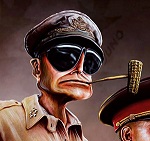vyelkin posted:I checked reviews for that book and it sounds like the case they're making is that Soviet anti-air forces and aircraft were much more closely integrated into the Egyptian military and the era of interwar conflict from 67-73 than was previously realized. They claim Soviet pilots were flying recon flights over Israel and intercept missions over Egypt, and Soviet troops were directly involved in Egypt's air defence against Israeli air missions. They also argue that the supposed breakdown in relations between Sadat and Moscow that led to Egypt demanding Soviet advisers leave was actually a planned withdrawal because the advisers' mission was completed - they had handed over all their equipment and finished training the Egyptian military how to use it. Apparently they then go on to claim that maybe the advisers didn't even leave afterwards, making it a successful deception to convince the Israelis that a breakdown in Soviet-Egyptian relations meant no attack was imminent, when in fact Egypt was gearing up for the Yom Kippur War. Ok thank you!
|
|
|
|
|

|
| # ? May 27, 2024 08:08 |
|
i have a question about bananas specifically at what point do they become a common grocery staple and how and why at which historical moment do they become the kind of food you can expect to be able to eat at any european hotel whenever you feel like it no matter what season it is
|
|
|
|
Some Guy TT posted:i have a question about bananas specifically at what point do they become a common grocery staple and how and why at which historical moment do they become the kind of food you can expect to be able to eat at any european hotel whenever you feel like it no matter what season it is they're from asia but really blew up in new world plantations, and were ubiquitous by about the late steamship era. bananas are year-round growers unlike oranges
|
|
|
|
late steamship? thats a lot earlier than i would have thought. do you have any references?
|
|
|
|
just wikipedia. says consumption exploded between the end of the civil war and the 1890s
|
|
|
Some Guy TT posted:late steamship? thats a lot earlier than i would have thought. do you have any references? How would you transport bananas by sailboat from Ecuador to Europe in edible condition?
|
|
|
|
|
The bananas they were eating went extinct in a plague and it's why banana taffy tastes so weird
|
|
|
|
Slavvy posted:How would you transport bananas by sailboat from Ecuador to Europe in edible condition? He said bananas becoming popular in the steamship period was earlier than he thought, you buffoon!
|
|
|
|
Slavvy posted:How would you transport bananas by sailboat from Ecuador to Europe in edible condition? Bananas as distinct from plantains didn't yet exist when sail was the only option; the first recorded sweet yellow plantain was a mutant in the 1836 growing season in Jamaica, nearly 20 years after the first steam-assisted Atlantic crossing. Economic viability would have come around the 1880s when improvements in boiler technology made steam--which placed the entire Caribbean safely in range to deliver before rotting--similarly priced to sail even with good prevailing winds, primed by them already having become popular on the US east coast which could easily stock them by sail. Mass cultivation* of plantains reached the Americas through Europe to begin with, partially introduced by the Spanish who maintained Moorish plantations through their south but mostly by the Portuguese who had also brought it back from their exploration of west Africa. * As with the chicken, there are solid amounts of evidence that a few got through earlier from Polynesian one-time visits or castaways.
|
|
|
|
Mandoric posted:Bananas as distinct from plantains didn't yet exist when sail was the only option; the first recorded sweet yellow plantain was a mutant in the 1836 growing season in Jamaica, nearly 20 years after the first steam-assisted Atlantic crossing. Economic viability would have come around the 1880s when improvements in boiler technology made steam--which placed the entire Caribbean safely in range to deliver before rotting--similarly priced to sail even with good prevailing winds, primed by them already having become popular on the US east coast which could easily stock them by sail. not to mention that the earliest commercially-viable refrigeration unit was a massive ammonia-based coolant setup that needed a pretty powerful engine to run and first became widely available in the early 1870s. they were mostly used by breweries at first, but just as the improvements to boiler technology happen and companies switch to steamers, you also get refrigerated holds becoming pretty cheap. when it was first founded, the boston fruit company, which eventually became chiquita, was shipping bananas, coconuts, oranges, lemons, mangoes, and avocados and roughly half of its volume was in bananas all up and down the east coast.
|
|
|
|
https://www.amazon.com/Doing-Business-Dictators-Political-Silhouettes/dp/0842025901
|
|
|
|
Teriyaki Hairpiece posted:https://www.amazon.com/Doing-Business-Dictators-Political-Silhouettes/dp/0842025901 interesting timeframe, I think the biggest coup we did was in the Eisenhower admin
|
|
|
|
The Hessian Courier is an eight-page pamphlet, written by Georg Büchner in 1834, in which he argues against the social injustices of his time. It was printed and published following editorial revision by the Butzbach pastor Friedrich Ludwig Weidig. The first copies of the pamphlet were secretly distributed in the Grand Duchy of Hesse on the eve of 31 July 1834. The pamphlet is famous for its first line: "Peace to the huts! War on the palaces!" (Friede den Hütten! Krieg den Palästen!).
|
|
|
|
Modernity is all weird and bundled up in the French revolution. Equal rights for women took centuries despite deriving obviously from 1789 liberalism. There's unfulfilled goals of Seneca Falls, at least regarding religion.quote:He has never permitted her to exercise her inalienable right to the elective franchise.
|
|
|
|
platzapS posted:Modernity is all weird and bundled up in the French revolution. Equal rights for women took centuries despite deriving obviously from 1789 liberalism. There's unfulfilled goals of Seneca Falls, at least regarding religion. Maybe the Catholic Church but there's other options unless you believe that transubstantiation can only be done by man I guess.
|
|
|
|
War and Pieces posted:The bananas they were eating went extinct in a plague and it's why banana taffy tastes so weird This is one of the most common misconceptions of modern history. Banana candy tastes the way it does because of a chemical called isoamyl acetate - nicknamed banana oil because it smells somewhat like bananas - that was used to water-proof canvas airplane wings. It's made by combining a byproduct of alcohol distillation with vinegar, so it's cheap to produce. When airplanes started to be made of metal, there was a glut of banana oil, so companies used it to produce banana-flavoured candy. It was never intended to be a close match to the scent or flavour of bananas, it's just an extremely cheap chemical that happens to be close enough.
|
|
|
|
sullat posted:Maybe the Catholic Church but there's other options unless you believe that transubstantiation can only be done by man I guess. Protestantism is not an option
|
|
|
|
Chamale posted:This is one of the most common misconceptions of modern history. Banana candy tastes the way it does because of a chemical called isoamyl acetate - nicknamed banana oil because it smells somewhat like bananas - that was used to water-proof canvas airplane wings. It's made by combining a byproduct of alcohol distillation with vinegar, so it's cheap to produce. When airplanes started to be made of metal, there was a glut of banana oil, so companies used it to produce banana-flavoured candy. It was never intended to be a close match to the scent or flavour of bananas, it's just an extremely cheap chemical that happens to be close enough. it also tastes disgusting as gently caress while bananas are delicious
|
|
|
|
Maed posted:it also tastes disgusting as gently caress while bananas are delicious Yeah it's water sealant
|
|
|
|
HootTheOwl posted:Yeah it's water sealant
|
|
|
|
bring back leaded wine, it worked fine for the romans and tastes great!
|
|
|
|
Chamale posted:This is one of the most common misconceptions of modern history. Banana candy tastes the way it does because of a chemical called isoamyl acetate - nicknamed banana oil because it smells somewhat like bananas - that was used to water-proof canvas airplane wings. It's made by combining a byproduct of alcohol distillation with vinegar, so it's cheap to produce. When airplanes started to be made of metal, there was a glut of banana oil, so companies used it to produce banana-flavoured candy. It was never intended to be a close match to the scent or flavour of bananas, it's just an extremely cheap chemical that happens to be close enough. wait if banana oil was an actual thing then why was it also a slang term with a similar meaning to bullshit
|
|
|
|
seems like banana oil was a more pleasant industrial byproduct than castor oil
|
|
|
|
blackstrap best byproduct
|
|
|
|
Maed posted:bring back leaded wine, it worked fine for the romans and tastes great! I won't be truly free until I can drink sarsaparilla out of the family pewter
|
|
|
|
gradenko_2000 posted:seems like banana oil was a more pleasant industrial byproduct than castor oil This is pure polloux
|
|
|
|
gradenko_2000 posted:seems like banana oil was a more pleasant industrial byproduct than castor oil I don't think it's a byproduct. The seeds are like half oil and don't have any major uses once pressed that I'm aware of. I guess the pressed seed is good for fertilizer. Are you thinking of Castoreum from beavers?
|
|
|
|
nm
|
|
|
|
Slavvy posted:How would you transport bananas by sailboat from Ecuador to Europe in edible condition? Finding it surprisingly difficult to find historical travel time figures but I did find a current clipper cruise on a square rigged sailing ship doing Barbados to Portugal in 16 days.
|
|
|
|
you can still find gros michel bananas for sale just about anywhere bananas grow, they just arent grown at industrial scale anymore because of the blight. they also dont taste at all like banana candy, just like how grape candy doesnt taste like grapes, because its candy you doofuses.
|
|
|
|
Mr. Sharps posted:you can still find gros michel bananas for sale just about anywhere bananas grow, they just arent grown at industrial scale anymore because of the blight. they also dont taste at all like banana candy, just like how grape candy doesnt taste like grapes, because its candy you doofuses.
|
|
|
|
concord grapes do taste like grape candy tho
|
|
|
|
Samog posted:concord grapes do taste like grape candy tho "time traveler giving a French serf a Dorito" but it's a goon eating gros michel bananas or concord grapes.
|
|
|
|
Fat Mike ftw
|
|
|
|
Wasn't Gors Michael the name of Michael Ceras character in arrested development
|
|
|
|
why are you eating bananas from a guy called Gross Michael??
|
|
|
|
Weka posted:Finding it surprisingly difficult to find historical travel time figures but I did find a current clipper cruise on a square rigged sailing ship doing Barbados to Portugal in 16 days. Clipper are the ultimate form of sailboat developed in the 1800s though. Everything before was significantly slower. Orange Devil has issued a correction as of 15:17 on Oct 15, 2023 |
|
|
|
Orange Devil posted:Clipper are the ultimate form of sailboat developed in the 1800s though. Everything before was significantly shower. Yeah I'm aware, the point of reference was late steam ships though.
|
|
|
|
Ronald Reagan's pronouncement, in his first inaugural address in 1981, that “government is not the solution to our problem, government is the problem” marked a signal moment in what has become the most successful political counterrevolution in modern American history. Having won a smashing electoral victory, Reagan acted as if he were the latter-day inverse of his long-ago political hero, Franklin Delano Roosevelt. Summoning the American people to “a rendezvous with destiny”—a line he had shamelessly filched from FDR in the 1964 speech on behalf of Barry Goldwater’s presidential campaign that established him as the Republican right wing’s future leader—and pretending that the stubborn stagflation of the 1970s was a crisis of the same magnitude as the Great Depression, Reagan channeled Roosevelt’s optimistic rhetoric to attack the instrument of Roosevelt’s great reforms: the federal government. He aimed, above all, to revive the laissez-faire economic and social policies that the Depression had discredited, that Roosevelt had supplanted, and that even Richard Nixon had repudiated when he declared himself a Keynesian. But Reagan’s antigovernment politics and policies went much further than rolling back the New Deal. Reagan’s Republican Party of 1981 was very different from Herbert Hoover’s of 1933: it had become the refuge of millions of formerly Democratic white conservative voters in the Solid South who resisted the civil rights reforms of the 1960s. Accordingly, behind his cheerful veneer Reagan made sure that he tapped into the fierce resentments of federal authority, dating back to the Civil War and Reconstruction, that fueled that resistance. Before they were done, the Reagan Republicans had absorbed into their coalition an array of aggrieved Americans, including quasi-theocratic white Christian nationalists, the gun-manufacturing lobby, antiabortion militants, and antigay crusaders. The antigovernment fervor that grips the nation today is the long-term product of the right wing that Reagan called to arms (literally, in the case of the National Rifle Association) forty-odd years ago. It was his attorney general Edwin Meese, in tandem with the newly formed Federalist Society, who started packing the federal judiciary with the conservative judges who have gutted federal protections for voting rights, abortion rights, and more, while inventing, with fake history presented as “originalism,” an individual’s Second Amendment right to own and carry military-grade armaments. It was the Reagan administration that eliminated the FCC’s fairness doctrine, which mandated that broadcasters provide balanced coverage of controversial public issues, paving the way for right-wing talk radio inciters like Rush Limbaugh and G. Gordon Liddy and, on cable TV, Rupert Murdoch’s Fox News to amplify antigovernment paranoia. The Reagan White House also harbored the former Nixon aide Pat Buchanan as its communications director. Buchanan’s politics were rooted in the 1930s America First isolationism of Charles A. Lindbergh and the diatribes of the right-wing “radio priest” Father Charles Coughlin, with their eccentric fixations on imaginary Jewish internationalist cabals. In the waning days of Reagan’s presidency, Buchanan remarked that “the greatest vacuum in American politics is to the right of Ronald Reagan.” He tried to fill that vacuum himself, nearly defeating President George H.W. Bush in the 1992 New Hampshire primary with his “pitchfork brigades.” His convention speech later that year laid out the culture wars to come. Then he followed up with another bid for the Republican nomination in 1996 and an independent campaign in 2000. All those efforts failed, but their stark themes of isolationism, lost national greatness, immigrant invasion, and racial fear provided a template for Donald Trump’s MAGA campaign a quarter-century later. “American carnage” was the favored far-right image at least two decades before Trump. Meanwhile, a step away from Buchanan—how distant a step has long been subject to debate—an assortment of antisemitic and white nationalist organizations remained on the political fringes during the Reagan period. The fringiest may have been the neo-Nazi National Alliance, founded in 1974 by William Luther Pierce, the author of the widely read novel The Turner Diaries, a lurid description of—and in some respects a blueprint for—a white supremacist revolution. The conspiracy-mongering Liberty Lobby, founded in 1958 by Willis Carto, claimed in the early 1990s a membership of 20,000, supplemented by 90,000 subscribers to its weekly newspaper, The Spotlight. In 1968 the Liberty Lobby supported the segregationist hero Governor George Wallace for president. Twenty years later the splinter Populist Party, which Carto helped to organize, nominated the former grand wizard of the Ku Klux Klan David Duke. In both 1992 and 1996 The Spotlight backed Buchanan. A major turning point in the Republican Party’s rightward radicalization and its fitful convergence with the evolving conspiratorial and white supremacist netherworld—populated today by groups like the Proud Boys, the Oath Keepers, and QAnon—came during the fall and winter of 1994, culminating in the spring of 1995. Much to the shock of Republicans who assumed that Reagan had created a national coalition that would last for decades, a Democrat, Bill Clinton, won the presidency in 1992. Republican strategists shifted their attention to Congress, and in November 1994, led by the firebrand Newt Gingrich of Georgia, the party captured the majority in the House of Representatives for the first time in forty years. Rewarded with the speakership, Gingrich dominated the news cycle with slash-and-burn denunciations of “sick,” “corrupt,” “anti-flag” Democrats. Advised by the political consultant Frank Luntz, he adopted his poll-tested vocabulary of demonization, published in a private memo entitled “Language: A Key Mechanism of Control”: “anti-child,” “decay,” “welfare,” “traitors.” Limbaugh, Liddy, and smaller-fry right-wing radio shock jocks added their own blend of conspiracy mongering and personal abuse. The prolonged and fatal siege in 1993 involving an armed religious sect, the Branch Davidians, and federal law enforcement in Waco, Texas, became a cause célèbre on both sides of the increasingly blurry border between the GOP hard right and the paramilitary extremists. “Go for a head shot,” the ex–Watergate plotter Liddy shouted into his radio microphone, instructing listeners on how to kill federal firearms officials. “The second violent American revolution,” Limbaugh declared around the same time, “is just about—I got my fingers about a quarter of an inch apart—is just about that far away.” Out of this toxic mix of cultism and grifting came Timothy McVeigh, a young, decorated army veteran, subscriber to The Spotlight, gun show enthusiast, and avid fan of Limbaugh’s. He had developed a burning hatred of Bill and Hillary Clinton and studied The Turner Diaries like a field manual. In April 1995, on the second anniversary of the end of the Waco siege, McVeigh parked a Ryder rental truck crammed with barrels of fertilizer explosive, flicked his Bic lighter to fire a five-minute fuse, and blew up the Alfred P. Murrah Federal Building in Oklahoma City, killing 168 people, 19 of them children. Nearly everything went according to plan that day for McVeigh and his accomplice, Terry Nichols, except the most important thing of all: their audacious attack failed to touch off a revolutionary uprising. Yet the fallout from what McVeigh and Nichols conceived as an act of war against the US government did nothing to pause the radicalization of American right-wing politics inside and outside the Republican Party, which continues to this day. As Jeffrey Toobin writes in Homegrown, the story of the Oklahoma City atrocity is “not just a glimpse of the past but also a warning about the future.” Toobin has established himself over the last thirty years as one of our premier legal journalists. His writings have included authoritative behind-the-scenes reports on John Roberts’s increasingly conservative Supreme Court, notably an enlightening book on the fraught relations between the Court and Barack Obama’s White House. Toobin has a special talent, however—a historian’s talent—for narrating the ins and outs of high-profile trials while placing them in their broader social and political settings. His books have become especially important as a chronicle of the 1990s; taken together they are among the most revealing and perceptive accounts of that decade yet written. Those on the O.J. Simpson murder case and trial (which overlapped chronologically with the Oklahoma City story), the Clinton impeachment, and the disputed 2000 election in Florida leading to Bush v. Gore offer a panorama of the crosscutting forces of race, class, and partisan politics that lay behind the courtroom dramas. Throughout US history the most important of our national conflicts have always eventually become legal and then constitutional struggles, and Toobin dramatizes that fundamental historical point as few other writers have. Although Homegrown covers some of the same themes as his earlier books on the 1990s, its story takes Toobin to what are, for him, some unfamiliar American places, including the bleak, hollowed-out upstate New York landscape where McVeigh grew up and the even darker landscapes he came to inhabit as a gun-loving right-wing drifter. Toobin also had access to a mountain of source material. In a move that raised eyebrows, in 1999 McVeigh’s lead attorney, Stephen Jones, donated his entire archive on the case, including all the government’s discovery material, to the University of Texas. In view of attorney-client privilege, this was, as Toobin responsibly discusses, ethically dubious, even though Jones’s client had by then been convicted and executed for his crime. For Toobin, though, the archive provided invaluable insight into the case, including (thanks to the oft-questioned McVeigh’s powerful memory) a nearly microscopic view of the terrorist’s activities, virtually from his childhood to the day he bombed the Murrah Building. The challenge for Toobin was to shape this overabundance of detail into a true-life crime-and-punishment story in which the chief perpetrator’s guilt is never in doubt and the outcome of his trial is virtually assured. The Simpson case turned on whether Simpson’s crafty attorneys could play upon passions linked to racism, policing, and celebrity, and lead a jury to dismiss clear-cut evidence of guilt. The Clinton impeachment was full of dramatic twists and turns, as well as a repellent cast of characters operating behind the scenes to pull it off; so was the 2000 Florida election debacle. By contrast, the central figure in Homegrown is no tortured Raskolnikov but a soulless fanatic who, beyond his messianic delusions, evidently had no inner life to speak of, let alone any complicating motives. The supporting cast, for the most part defense attorneys and prosecutors, although not without their quirks, elicit little fascination compared to the flamboyant Johnnie Cochran or the sanctimonious Kenneth Starr. The one character whose appearance might pique special interest is the then-as-now punctilious Merrick Garland, who as a prominent young Department of Justice official briefly oversaw the government’s investigation and prosecution of McVeigh, which gives an idea of the contrast with Toobin’s earlier protagonists. The only great drama in the book is McVeigh’s preparation and then the bombing itself, described by Toobin in just enough horrifying detail to underscore its barbarity and the suffering it inflicted, without sensationalizing it. He does manage to make the subsequent trial interesting by examining its inner workings, including clashing egos and lawyerly miscalculations. Toobin cannot, however, make it suspenseful, hanging as it did on whether the unrepentant McVeigh could somehow outwit the feds and prove them incompetent as well as oppressive, a narcissistic gambit that, even with the predictable prosecutorial flubs and missteps, had almost no chance of success. A subplot involving defense lawyers taking sumptuous trips all over the world, on the government’s dime, to try to track down supposed additional accomplices and masterminds shows just how far-fetched and self-aggrandizing their efforts became, but it finally amounts to a zany sideshow. As in Toobin’s other books, but even more emphatically, the essence of the story lies not so much in the crime and the trial as in the politics behind them. In the hours and days immediately after the bombing, suspicions gathered around the probability—even, some said, the certainty—that the bombers were foreign terrorists, most likely Islamic. The supposed terrorism expert Steven Emerson claimed on CBS News that the attack revealed a “Middle Eastern trait.” At the instant McVeigh was arrested wearing an antigovernment T-shirt, that framing began to shift. White House officials led by President Clinton—who from the start, based on his experience in Arkansas, was convinced the bombers were homegrown right-wing zealots—accused conservative demagogues of fomenting hatred of the federal government. In the news media, however, a portrait was painted of McVeigh not as a domestic political terrorist but as a troubled loner—a survivalist, perhaps, but in any case a one-off madman driven by personal demons. Conservative Republicans were particularly vigilant about deflecting anything that might associate them with the mass slaughter of innocent Americans. Even a year after the bombing, the widely syndicated conservative columnist Cal Thomas was still condemning the slightest suggestion that right-wing Republicans and their radio publicists bore any responsibility for it. According to Thomas, nobody had demonstrated that McVeigh or any other accused “crazies” like the Waco cultists had “ever listened to talk radio or read or heard a single speech by Newt Gingrich.” Yet reckless Democrats and their supporters in the press, Thomas charged, were outrageously blaming Republicans and talk show hosts “for contributing to a climate that produced these violent acts,” as if conservatives generally were “unindicted co-conspirators.” Toobin’s account shows incontrovertibly that this is precisely how the radicalizing right of the mid-1990s, in and out of the Republican Party, ought to be regarded. To be sure, much of McVeigh’s biography reads like that of a generic disturbed and violent criminal: an anomic childhood in a declining Rust Belt small town; divorced parents; sporadic employment after high school; an inability to form romantic or other emotional bonds; an early obsession with guns, followed by combat service in the Gulf War; and then a seminomadic life on the periphery, split between his childhood home outside Buffalo and the Middle American heartland. At one point he spent much of his time shuttling between gun shows while subsisting on fast food and Pepto Bismol. It took, however, a political self-education to turn a young man living on the edge into the terrorist Timothy McVeigh. At some point not long after high school, McVeigh obtained—via the National Rifle Association’s magazine, American Hunter—a mail-order copy of The Turner Diaries, which offered him a worldview that he never relinquished. From this book, written at the furthest reaches of antigovernment paranoia, he eventually extracted the basic instructions on how to touch off, with a spectacular act of terror, a white supremacist revolution that would overthrow the federal government. (This in turn, according to the novel, would lead to a nuclear war and then a race war, and finally the systematic extermination of all nonwhites and Jews.) But it was only after leaving the military that McVeigh began acting on his antigovernment animus. The brother of his army buddy (and later co-conspirator) Terry Nichols, while McVeigh was visiting them in Michigan, introduced him to The Spotlight, which, he would later tell his lawyers, pretty much summed up “my world/my culture…the stuff I identify with…stuff I know and live.” Around the same time, McVeigh began listening to Limbaugh, who was just coming into his own as a best-selling author, television performer, and talk radio megastar. “As they say, ‘Rush is right,’ (double meaning),” McVeigh wrote to a friend, “and many people (opponents) consider his views extreme.” He became an ardent fan. It was the Nichols brothers, meanwhile, who along with Limbaugh made McVeigh aware of Buchanan, then running his presidential primary campaign against George H.W. Bush. (Limbaugh, like The Spotlight, endorsed Buchanan’s bid.) As Toobin explains, Buchanan rounded out McVeigh’s political thinking, above and beyond—but by no means in contradiction to—the crude racism of The Turner Diaries. From Buchanan, McVeigh learned of the menacing New World Order (NWO), purportedly a project of shadowy, powerful, internationalist elites to topple the America created by the Founding Fathers and replace it with a single omnipotent world government run exclusively by and for themselves. From Buchanan, he learned that a new revolutionary resistance could defeat the NWO much as the patriots of 1776 had defeated the British. And from Buchanan, perhaps most important of all, he learned that, just as the redcoats had once tried to strip the patriots of their arsenals, so the nefarious globalists and their liberal minions were out to shred the Founders’ Second Amendment and seize the guns of a God-fearing citizenry. For Buchanan, Toobin writes, “guns meant freedom.” McVeigh already believed as much, but Buchanan politicized that belief as never before. Instead of Buchanan, however, voters eventually turned not to Bush, who would have been bad enough, but to Clinton, and McVeigh’s political rage found a new fixation. Judging from Toobin’s account, it is impossible to overestimate McVeigh’s hatred of Clinton, especially after the conflagration in Waco barely three months into his presidency, which to the extreme right was proof that the government’s attack on guns and freedom had begun in earnest. Through 1993 into 1994, right-wing talk radio inciters led by Limbaugh fanned the flames further with malicious conspiracy mongering, including the cruel lie that the Clintons had been responsible for the death of deputy White House counsel Vince Foster, their old friend who had committed suicide after being subjected to a campaign of false accusations of wrongdoing by the conservative editorial writers of The Wall Street Journal. During a brief visit home, McVeigh startled his father by muttering, whenever Clinton appeared on the TV, “Someone should kill that son of a bitch.” What he hoped someone else would do to the president, McVeigh did symbolically to the First Lady. In the late summer of 1994, while living in a house in rural Kansas and having finally decided to take up arms against the government, McVeigh and Nichols thought they should work on their sharpshooting. McVeigh set up a life-size silhouette for a target to which he then attached a photograph of Hillary Clinton. Apart from the Waco fiasco and the right-wing media assaults, Clinton’s presidency got off to a rocky start, as an early ginned-up controversy over gays in the military gave way to hard fights over passage of the North American Free Trade Agreement and a vicious struggle over the administration’s ambitious health care reform plan. By the late summer of 1994, the health care bill was spiraling toward defeat. With the midterm elections looming, Clinton and congressional Democrats were determined to show the voters a major victory. They got it in September when, after heavy lobbying by the White House, the Senate passed the Federal Assault Weapons Ban as a crucial part of the administration’s comprehensive Violent Crime Control and Law Enforcement Act—the seriously misunderstood Crime Bill of 1994, now widely maligned as a racist measure to incarcerate blacks. Prohibiting for ten years the manufacture for civilian use of certain semiautomatic weapons and large-capacity ammunition magazines, the measure aimed to curtail a recent alarming rise in the number of mass shootings. It was successful, not only in that regard but in reducing the proportion of overall gun deaths due to mass shootings, until the George W. Bush administration allowed it to lapse in 2004, with horrible if predictable long-term results. At the time, though, the ban was politically risky for the White House and the Democrats in view of Republican opposition to any limitations on gun manufacturing and ownership. The following January, shortly after taking office as Speaker, Newt Gingrich assured the NRA that, with a Republican majority, “no gun control legislation is going to move in committee or on the floor of this House.” More than historians have allowed, the assault weapons ban was a major contributing factor to the Democrats’ historic defeat in the 1994 midterm elections. For McVeigh, however, as he later told his lead attorney, the ban was “the last straw.” Clinton’s signing in 1993 of the Brady Handgun Violence Prevention Act, requiring background checks on individuals attempting to purchase certain firearms—named in honor of Reagan’s press secretary James Brady, who was shot and partially paralyzed during John Hinckley Jr.’s assassination attempt on Reagan in 1981—had angered McVeigh. But as the indictment papers against him stated, the plot that led to the bombing began on September 13, 1994, the date that Clinton signed the assault weapons bill. Although McVeigh may at that moment have wanted more than ever to see the president dead, he took instruction from The Turner Diaries and blew up the Murrah Building. But as Toobin emphasizes, although McVeigh attacked the federal government, hoping to initiate its overthrow, he also had a more specific target in mind: the Clinton administration. To that extent, he was perfectly aligned with his political heroes on the Republican right, who would continue to escalate their war on Clinton long after McVeigh was gone, on into the impeachment and the succeeding volume, chronologically, of Toobin’s multivolume history of the era. Toobin wants his readers to understand how the politics of the mid-1990s prefigured those of our own times and how the slaughter of April 19, 1995, connects to the rampage of January 6, 2021. The links are vivid enough: in the assurance that sinister “globalist” forces are either about to take control of the country or already have; in what Toobin calls “the belief in the value and power of violence”; in an obsession with gun ownership that reduces the entire Constitution to a twisted version of the Second Amendment; in a crackpot narrative of American history that turns liberalism into tyranny on the supposed authority of Thomas Jefferson. “How dare you call yourselves patriots and heroes!” Clinton declared in 1995, adding that “there is nothing patriotic about…pretending that you can love your country but despise your government.” In 2022 Joe Biden proclaimed that “we can’t be pro-insurrectionist and pro-American.” The largest difference between now and then, Toobin says, is frightening. Whereas McVeigh, only superficially a lone terrorist, found a kind of community in right-wing periodicals, talk radio call-ins, and far-flung gun shows, the Internet and social media have at once vastly enlarged that community and tightened its connections, with billions of unfiltered rants and orders and falsehoods flashing through the ether. McVeigh thought it would take a grandiose act of targeted terror to arouse what he only sensed was an immense army of like-minded militant patriots. Today’s extremists not only know with certainty that the army exists; they are in contact with it and are counting on its triumph, whether in the Storm or the boogaloo or some other revolutionary apocalypse. And with the Clinton assault weapons ban a distant memory, they are armed to the teeth. But while it warns about the present danger, Homegrown also illuminates and bids us to reckon with the larger history of what happened in 1995. Not only do today’s distempers date back well before Trump or the Tea Party; they originated well before the inflamed mid-1990s, taking their modern form during the presidency of Ronald Reagan, who encouraged them with his denunciations of the federal government as a malevolent force. And there is an even longer history behind that. The great revolutions in American history—from the nation’s founding through Emancipation, Reconstruction, the Progressive Era, and the New Deal—have been predicated on the idea, inscribed in the Constitution, that it is the nation, the more perfect Union striven for in 1787, that is best equipped to secure the common good and the general welfare. Counterrevolutionaries in their various forms—nullifiers, Confederates, so-called Redeemers overthrowing Reconstruction, anti–New Deal Liberty Leaguers—have fought that idea, never more successfully than in the long counterrevolution begun under Reagan. Though resisted and even halted from time to time, that reaction, steadily radicalized, has now turned a substantial number of Americans against their own government, and they are ready and willing to use violence for their retribution. In the process, large and influential elements of the party of Abraham Lincoln—a party that fought against one such counterrevolution—have become captive to that subversive rage.
|
|
|
|

|
| # ? May 27, 2024 08:08 |
|
lol sorry sean i dont care how good the book is, im not reading anything by the guy that beat off on live CNN
|
|
|

































